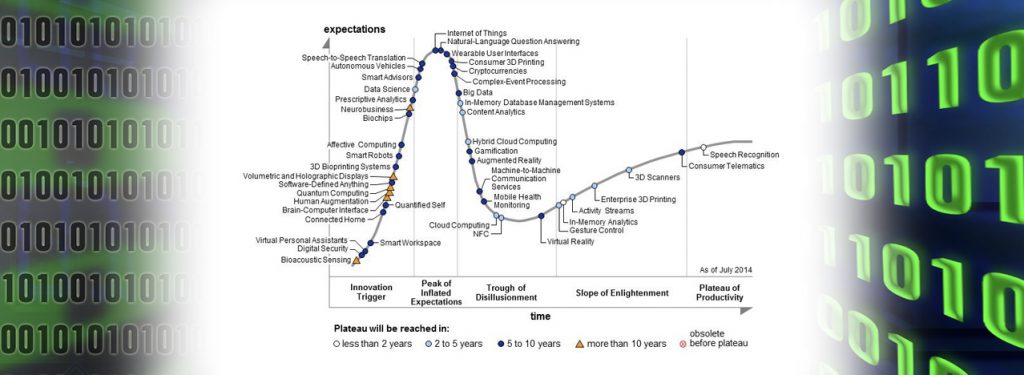Big (Data) Expectations
Gartner has a pretty terrific article on the 2014 Hype Cycle, and it is interesting for a lot of reasons. There is the cool figure that charts out various technologies and where they exist on the current “Hype Cycle” timeline.

So there is a lot here, but one of the interesting pieces is Gartner’s estimation that Big Data is slowly sliding into the “Trough of Disillusionment.” What does this mean, exactly?
There’s been a lot of hype about Big Data, so perhaps it is no surprise that Big Data has ended up on this Hype Cycle. We have talked about this before, and a lot of smart people — at iVEDiX, and elsewhere — have noted that the concept of Big Data is, in the wrong hands, easily abused. A lot of misinformed folks seem to think that “Big Data” simply means “lots of data” but that is not the whole story. And while we don’t to rehash the various arguments over Big Data in this post, it is worth pointing out that the fact that Big Data is on the down slope does not mean it isn’t a viable technology. As you can see from the above graphic, it just means that after it bottoms out, Big Data will plateau and ultimately show its value. Remember: this cycle is about efficacy, it is about hype.
The other reason this graphic is interesting is because the bell curve shape reminds me quite a bit of the innovation curve.
The Diffusion of Innovations is an interesting theory that has been around a long time. It describes the way that technology is adopted by the population at large, and has been used for decades as way to understand the flow of communication and ideas when it comes to new technologies.
Of course, the two graphs are showing different things: expectations and adoption, respectively. But it is interesting how both of them display a similar curve in the beginning. Like the Innovators and Early Adopters, it appears there is a ramp up when it comes to expectation.
It is probably not a good a idea to extrapolate some kind of relationship between these two trends, but the statistical trends for both are interesting nonetheless.
What do they tell us? If nothing else, they point out that the height of excitement — whether it is talk or action, expectation or adoption — precedes a gradual lessening of that same excitement. But it also seems that this isn’t something we can know ahead of time.
So if anything, these curves are a great reminder that the inevitable slowing-down of excitement or adoption isn’t the death knell for a product or an idea. In the beginning of this post I mentioned Big Data, and how it is on the down slope, approaching a trough of disillusionment. But again, this doesn’t mean Big Data isn’t going to bear productive fruit — it just means that, as the hype wears off, we will be to talk with more frankness about what Big Data is, and how useful it can be to us. And ultimately, that is what we should care about the most: hype is great and all, but can we actually use the thing we are all excited about?
What technologies do you think get a lot of hype? Is it deserved? 

![800px-Diffusion_of_ideas.svg[1]](http://www.ivedix.com/test2019/blog/wp-content/uploads/2014/08/800px-Diffusion_of_ideas.svg1_-300x225.png)


